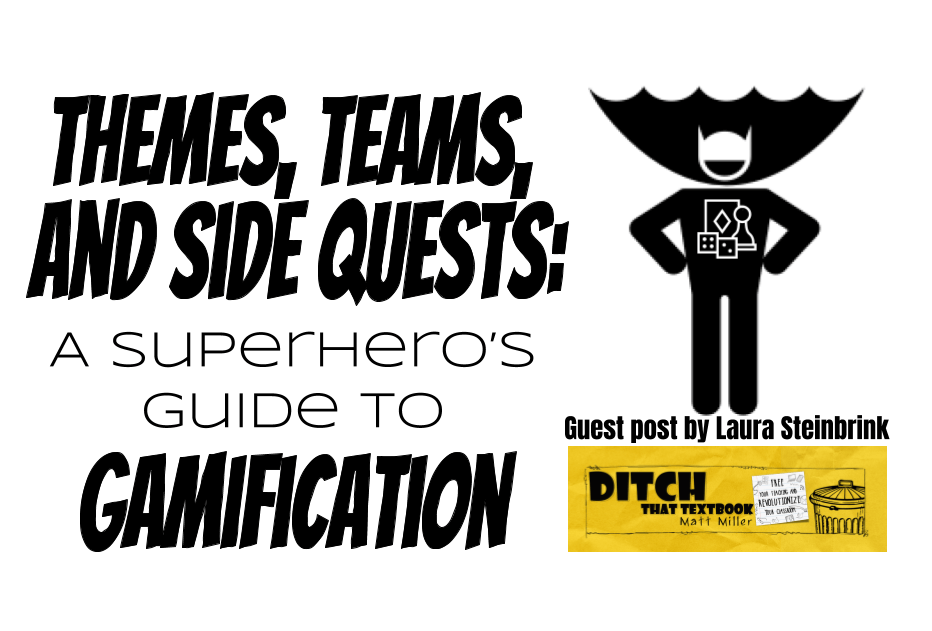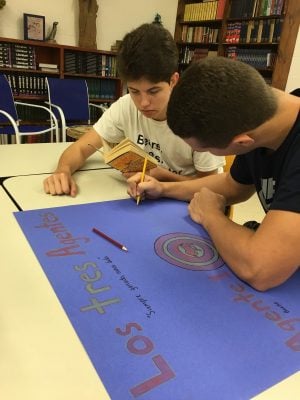

Games are fun. They add excitement, engagement, and some friendly competition. Building your games around a theme takes your gamification to a whole other level. Here is a guide for getting started.
Gamification in education is not new, and thanks to Michael Matera and his book, Explore Like A Pirate, a thriving community has been formed that helps educators all over as they start their own journey.
If you are already a part of that amazing community, then high fives and woot woot! If you are on the fence about gamifying your own classroom, watching the fun but afraid to climb down and join in, then we’ve got you covered.
I went the Marvel Agents of Shield route so that I could have secret missions and all kinds of spy stuff. My students have really enjoyed helping me come up with ideas too. We’re creating things as we go, but the storyline of recapturing the Infinity Stones has tapped into, well, an infinity of possibilities.
Let’s look at the Three Gamification Commandments that you can adopt, adapt and use to access the elements of games that hook your students.
This might seem like the toughest or most challenging thing to do, but don’t skip this step. Figure out what your theme is before you begin this journey. Don’t get bogged down in too many details so that you never actually gamify your class. I am not a gamer personally, but my daughter, husband, and son are big-time gamers. They keep me up on the latest sensations and trends and explain patiently (or not) about the different mechanics that they love the most. Regardless of the theme you choose, you can add in aspects of any game, movie, or pop culture fad.
Here are a few ideas for themes if you need a place to start:
Movies/TV Shows: Superheroes! Who doesn’t want to be a superhero! While I am a Marvel fan, I like DC too, and both had their heroes work in teams, and both have rolled out movies to that effect. This is a prime opportunity for you to create a fun theme. (Note: If superhero type movies aren’t your thing, go with something else that is popular and age-appropriate, like: Pirates of the Caribbean, Transformers, National Treasure, Disney, Stranger Things, X Files, Harry Potter, Star Wars, Star Trek etc.)
Classic games: Ex. Oregon Trail (great for a geography theme and how fun would it be to throw in some dysentery as a curveball or award a perfect fording of the river (survived an obstacle) as you avoid places that can’t support your oxen). Don’t forget to have the card game on hand for some extra fun or mischief!
Game Shows: If you enjoy Wheel of Fortune, Family Feud, and other game shows, then you can start there! If you want to try a Family Feud theme, then students would be grouped into families. They could come up with family names, mottos, crests, and more.
Every so often during a lesson, you could have a survey question based on your content that two families can play. Wheel of Fortune your game instead? Have a wheel in your room. A member from every team can randomly and at specific times come up and spin the wheel. Where you take it from there is up to you. Students love the element of chance that spinning a wheel brings, and don’t forget to include nonsense but totally fun items on your wheel too.
Teams and team building can be a powerful addition to any classroom, gamified or not. No matter when you choose to get down off the fence and try gamification, get your teams organized as soon as possible. This can be done simply, and since every student, class, and grade level is different, how you organize them is best left up to you.
Here are some basics that will help you think over what will work for you:

Students working on their poster. I left my walls blank so that they could be decorated by all of the team posters.
Give the teams a task as soon as they are formed. As a high school teacher, I had my students decide for themselves as to who would be in which team, and the only instructions they had pertained to the number of students per team and types of skills needed per team. This won’t work for everyone, so tailor the instructions to fit your students, but don’t leave this step out. A team identity has power that a group doesn’t. Since we are doing a Marvel Agents of Shield theme, my students had to get in their teams and create a poster that contained their team name, a team logo, agent names, and a team motto. The motto had to be something that would inspire them when the going gets tough. Most teams even came up with icons or logos for each agent in the team.
Learn your team names and their members so that you can refer to them correctly, challenge and encourage them as a team or as individuals as needed, and remember to award game points (not grade points) to individuals and to teams as you get a handle on how you want your “game” to run.
To mix things up a bit for more cooperative learning activities, have teams do a member swap for special missions, quests, or challenges. Occasionally, require each team to send a member to you for a special assignment. They must join a different group for a specific task. You can mix them up as needed. The next time you do it, teams have to submit a different member until all have been a part of a different team. You can keep mixing them up throughout the year for those special tasks.
Side quests or missions are an excellent way to get your students involved in the learning process. These are in addition to your normal content, and they are not for grades. In fact, gamification has the power to move the learning motivation away from just getting a score.
Spend time before each school year or at any time during it to see what the popular games, movies, and trends are. It’s good to stay relevant, though classics are always a good choice too.
Here are some ways techy ways you can spice up your game with side quests:
Hide QR codes around the classroom, your building, or district (or really go big and hide them around your community) that present challenges, secret missions, or clues to solving a problem.

Mission clue example. Can be independently hidden via QR codes throughout the district and then secretly completed by teams for experience points (XP).
Create a Breakout EDU Digital where the clues lead students all over the place. What they are actually breaking out of can be tied into your theme. In fact, like many popular games and movies, maybe the students aren’t breaking themselves out but are rescuing someone or something. Unlike traditional Breakouts, this could require deeper thinking and can last for as long as you want it to last.
Students start with a clue in the classroom or embedded in the content of the lesson, and then the fun begins! They have to solve a content related problem to unlock the next clue, which in turn leads them to another problem and another clue until the last lock is unlocked and then someone or something is rescued!
Want to create your own Breakout EDU Digital game? You can use this template for planning your games. Tools like Flipgrid, Synth, Adobe Spark, Kahoot, Quizizz, Quizlet, and Pear Deck are just a few that can be enlisted for this mission. You can see LOADS of example games on the Breakout EDU Digital Sandbox site.
While this is just scratching the surface of gamification for our classrooms, it is an easy place to get started. Figure out your theme, teams, side quests and get your game on! Want to tap into those popular games that your students are playing? Add a dance when teams reach a certain level. The first team to reach that level gets to make up the dance.
Whatever you decide, remember that it doesn’t have to be perfect or finished. Your plan should be fluid, changing with your students or even on a whim. Are you ready? Have you begun to climb down off of that fence of indecision? To quote one of my favorite characters, the Norse god of thunder, Let’s do this.
Related posts:
For notifications of new Ditch That Textbook content and helpful links:
Interested in having Matt present at your event or school? Contact him by e-mail!
Matt is scheduled to present at the following upcoming events:
[getnoticed-event-table scope=”upcoming” max=”15″ expanding=”false”]

Session expired
Please log in again. The login page will open in a new tab. After logging in you can close it and return to this page.
[…] 9. Create missions for students using a fun theme with QR codes. […]